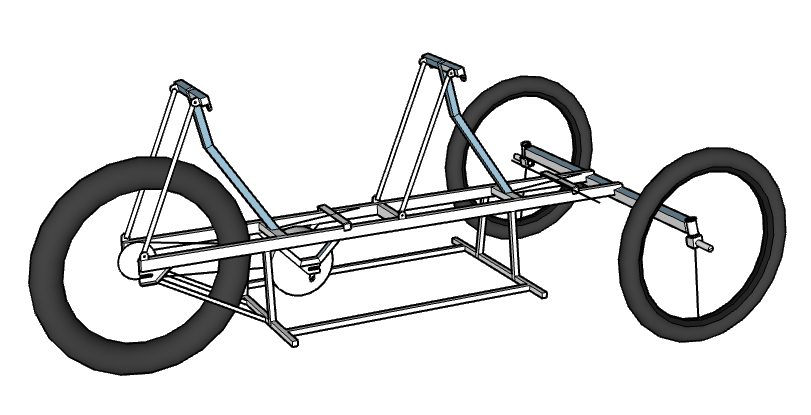|
Since I last posted, I have gotten the seatbacks mounted, chains routed and brakes hooked up, and I have taken the Raven for a few test rides on pavement and dirt roads. The test rides have taught me four things.
Much of this weight and complication in the steering, chain and cable routing is due to my desire for the seats to be low to the ground. The low center of gravity does make the trike feel planted, even with a narrow-ish track (38"), but the complication it has caused is too much of a compromise for a real-world, everyday application. So, I have redesigned the main frame. The design is much, much simpler. It uses two main tubes, a straight crossmember, simple underseat (or overseat) steering design with two tie rods instead of three, utilizes aluminum seatback support tubes, single upright seat supports and now all power is routed to the rear wheel through the mid drive, which reduces the number of chains required, eliminates the need for a special tandem shift cable and should also allow chain routing to only require one power-side idler as opposed to 4. Also, the wheelbase has been reduced by over 2 FEET (609mm), which will greatly improve the turning radius.
The compromise here is that the seats are about 6" higher off the ground than the previous design. To counteract this higher center of gravity, I will likely increase the track width by as little as 5" and possibly as much as 10", for an overall width around 48". The seats are also 10° steeper, putting them at 55° rather than 45°. This puts the occupants in a position more similar to driving than before. I am also going to have the bottom bracket a bit lower to the ground so that visibility and chain line are optimized when it comes time to build the shell. If it's not already clear to my readers, all of these changes basically mean starting over. The seats and tie rods will be re-used, but the rest will be cut apart and the usable pieces will be saved to be used as scrap parts for the next build and future projects. This is, unfortunately, one of the realities of prototyping experimental vehicles. This is not the end, but unfortunately it is enough of a setback that the project needs to be put on hold. Partially because of financial reasons, but also because by September 1st, my Fiancé and I will have moved to Boston for her postdoc position she was offered at MIT. Should we find suitable arrangements including a garage for me to work from, this build will resume part-time with the new, simpler redesign around then. Until then, I need to begin working again, packing up my tools and parts, and preparing to move our lives a 29-hour drive away. If you know of any bicycle shops in Cambridge looking for an experienced mechanic to wrench in and/or manage a service department, I would greatly appreciate the introduction! Until then, I will post any updates here that I think you all will find entertaining, and I'll get back to work on this project as soon as I can. - Chase
2 Comments
John Westlund
7/29/2021 11:55:01 am
Hopefully you can find a place to continue progress. I like your work. You did choose to forego suspension though. In many parts of the U.S., the roads are so terrible that it is not optional and your trike will tear itself apart without it and you could easily lose control of the vehicle. I speak from experience on this, unfortunately. Having 350-400 lbs of load on an unsuspended frame greatly increases the amount of mass of frame/components needed to handle the load, possibly moreso than the weight a simple suspension would add. Ever been sent airborne from hitting a pothole at 20+ mph? I have, had no control of the trike for the duration, and could have easily lost control and flipped once re-establishing traction with the ground if I changed my steering trajectory before hitting the ground. Adding a front suspension fixed that and made the trike a lot more controllable.
Reply
Chase
10/26/2021 08:44:22 am
Thanks for the comment John!
Reply
Leave a Reply. |
Archives
March 2024
Categories |
Search by typing & pressing enter


